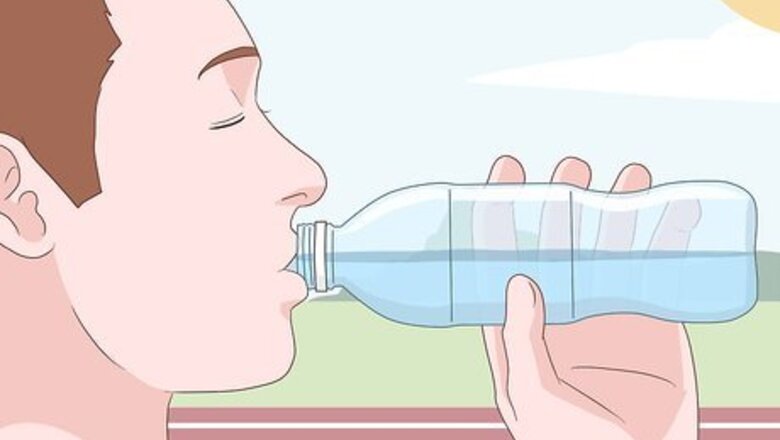
views
Reducing Lactic Acid During a Workout

Stay hydrated. Lactic acid is water-soluble, so the more hydrated you are, the less likely you may be to feel a burn while you workout and cause lactic acid build up. More research is needed to confirm the link between hydration and lactic acid buildup, but drinking sufficient water while exercising has no negative consequences. It’s now believed that lactic acid does not contribute to muscle soreness as much as was once thought, and “flushing it out” is largely unnecessary. Drink plenty of fluids while you work out, as well as before and after your workout. Keep in mind that by the time you notice you are thirsty during a workout, you may already be dehydrated. Drink 17–20 oz (0.5–0.6 L) of water 2–3 hours before you workout, 8 oz (237 mL) of water 30 minutes before you workout, 7–10 oz (207–296 mL) every 10–20 minutes during your workout, and 8 oz (237 mL) no more than 30 minutes after you’re finished.
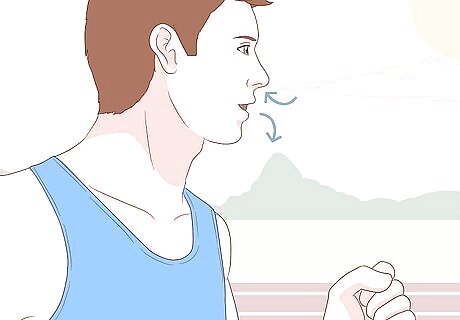
Breathe deeply. The cause of the burning sensation you feel in your muscles while exercising is twofold; it is partly due to the buildup of lactic acid, but it is also due to a lack of oxygen. Ameliorate this by paying close attention to your breathing while you exercise. Be sure to breathe deeply in and out at an even pace. Try breathing in through your nose and out through your mouth. This will help to deliver oxygen to your muscles and reduce the production of lactic acid. When you breathe deeply and intensely during your workout, you might not feel as sore afterward. Physical therapist Eric Christensen, DPT also says, "breathing more...dispel[s] the hydrogen ions" that contribute to muscle pain "through respiration."
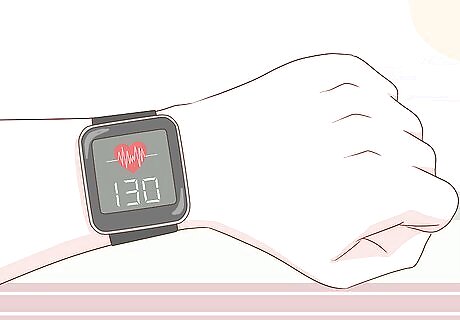
Check that your heart rate is in the appropriate range. Pushing yourself too hard is what causes lactic acid buildup. Your heart rate should be in a fat burning or cardio range, depending on your goals. Although short bursts of exercise above this threshold can improve your aerobic health, make sure you do not go beyond your cardio range for longer than 1–2 minutes at a time. Most of your workout should be below your anaerobic threshold, which you can calculate using your age: First, calculate your maximum heart rate by subtracting your age from 220. For example, if you are 30 years old, you'd calculate 220-30=190. Your maximum heart rate would be 190 beats per minute. Next, calculate your fat burning range by multiplying your maximum heart rate by 50% and 70%. You'd multiply 190X50%=95 and 190X70%=133. For a 30-year-old, the fat burning range is 95–133 beats per minute. Finally, calculate the cardio range by multiplying your maximum heart rate by 70% and 85%. For example, 190X70%=133 and 190X85%=162. The cardio range for a 30-year-old is 133-162 beats per minute. If this person's heart rate exceeded 162 beats per minute, they would be pushing themselves too hard. This is their anaerobic threshold.

Work out frequently. The more physically fit you are, the less glucose your body will need to burn. This means less lactic acid will build up since it comes from glucose that is broken down. This is because your body gets more efficient at burning calories and expending energy. You need to expend less effort to do the same activity.Tip: Increase the intensity of your workouts gradually. Develop a workout plan to add minutes or repetitions slowly to your routine. This will gradually raise the level at which your body starts to produce lactic acid. Try to work out several times a week, but make sure to take at least one or two rest days to allow your muscles to recover.

Be cautious when lifting weights. Weightlifting is an activity that tends to promote lactic acid build up because it requires more oxygen than our bodies can deliver. Although we have been told to "feel the burn," a buildup of lactic acid may also lead to micro-tears that can cause trauma in the muscles and leave you sore for days. Be sure to increase the weight and repetitions gradually to keep healthy levels of lactic acid in the body.

Decrease the intensity of your workout if you start to feel a burn. The burning sensation you feel during intense exercise is the body's defense mechanism trying to prevent overexertion. You should not experience pain during a workout. If you are doing aerobic activities, like running, walking fast, biking or using an elliptical or stair stepper, slow your speed. If you are doing weights, lower the number of repetitions or reduce the weight. As you catch your breath, more oxygen will be delivered to your muscles and release the lactic acid.

Stretch after your workout. Since lactic acid disperses 30 minutes to an hour after your workout, stretching helps to release lactic acid, alleviating any burning sensations or muscle cramps you might be experiencing. Stretching feels good and helps prevent injury after a workout, which can prevent pain from injury later. However, studies show that stretching may not significantly reduce post-workout pain in some healthy adults. Stretch your muscles lightly following any intense exercise, and also use your fingertips to massage the area gently. Physical therapist Eric Christensen, DPT says, "Self massage or foam rolling is great...because it promotes tissue mobility" and circulates more healing nutrients. This will also decrease any micro-trauma that may be responsible for soreness in the days following a workout.

Stay active. Rest after your workout, but lead an active life. Muscles need activity as well as oxygen and water to stay healthy. If you feel a burn in your muscles occasionally, there is no cause for alarm; lactic acid in small amounts is not damaging to your body and may even have some beneficial effects on your metabolism. In small amounts, lactic acid helps your body more easily absorb energy. It also burns more calories. Additionally, spending short periods of your workout in an anaerobic state allows you to improve your cardio endurance over time.
Reducing Lactic Acid Through Your Diet
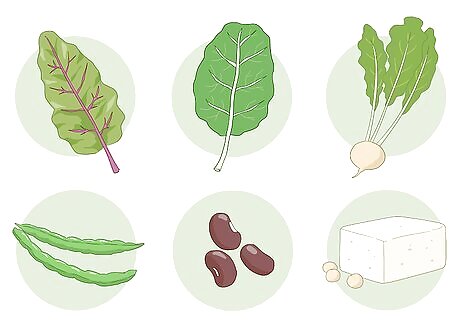
Increase your magnesium intake. The mineral magnesium is essential for proper energy production within the body. Healthy magnesium levels will help the body to deliver energy to the muscles while exercising, thus limiting the buildup of lactic acid. Therefore, you should make an effort to increase your daily magnesium intake, preferably through your diet.Tip: Vegetables like Swiss chard, spinach, collard greens, turnip greens and green beans, legumes like navy beans, pinto beans, kidney beans and lima beans, and seeds such as pumpkin, sesame and sunflower seeds are all excellent sources of magnesium. Tofu—especially nigari tofu—is particularly rich in magnesium. It is also possible to increase magnesium intake through supplements, however, with a healthy diet rich in the food sources described above, this should not be necessary.
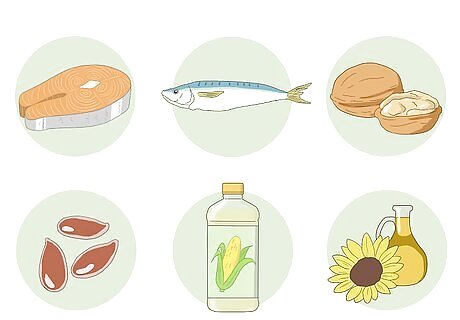
Eat foods rich in fatty acids. A healthy intake of foods rich in fatty acids helps the body to break down glucose, a process which is essential for normal energy production. This can help to limit the body's need for lactic acid during a tough workout and keep you going for longer. Get essential fatty acids from cold water fish like salmon, tuna and mackerel, from nuts and seeds like walnuts and flaxseed, and from plant oils such as corn oil, sunflower oil, and soybean oil. Fatty acids also work to reduce inflammation. This may lessen muscle soreness in the days following a tough workout.
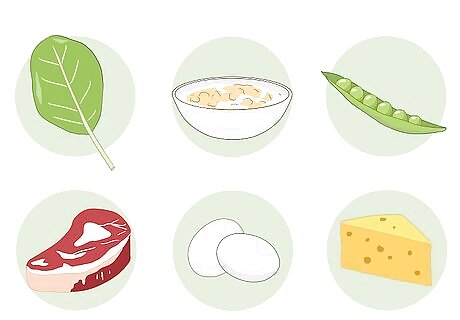
Eat foods containing B vitamins. B vitamins are useful in transporting glucose around the body, which helps to fuel the muscles during a workout, thus reducing the need for lactic acid. Foods that contain high quantities of B vitamins include leafy green vegetables, cereals, peas and beans, along with protein-rich foods such as fish, beef, poultry, eggs, and dairy products. Foods high in B vitamins also help to replenish the body with other nutrients that are lost during intense exercise.
Recognizing Lactic Acid Build Up
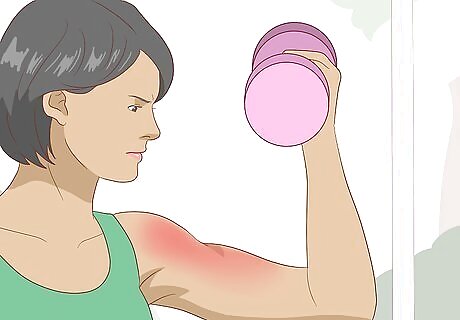
Notice the burning sensation in your muscles caused by lactic acid. When you work out, your body normally relies on stored glucose and the oxygen you breathe to fuel your body. However, a hard workout can push your body too far too fast, making it hard for your oxygen and glucose stores to keep up. Your body then releases lactic acid to fuel your body, which is called going into an anaerobic state. Lactic acid is also called lactate. Your body can only continue in this anaerobic state for so long. You'll naturally feel fatigued as you reach your limit.

Recognize that lactic acid is useful for your body in most cases. Lactic acid naturally results when your body converts glucose to energy during exercise. It actually allows your body to absorb and use this energy. However, it can become a problem if you push yourself too hard for too long. In most cases, the effects will go away on their own. It's possible for too much lactic acid to cause lactic acidosis, but this is not a common condition.

Watch for symptoms of harmful lactic acid buildup. While it's not usually a concern if the lactic acid builds up as a result of working out, lactic acidosis can happen. If you recognize symptoms of this condition, talk to your medical provider. Do not attempt to diagnose yourself. These are the symptoms of lactic acidosis: Feeling disoriented General weakness Yellowing of the skin Yellowing of your eyes Breathing issues, such as shallow or rapid breathing Rapid heart rate Pain or cramping in your muscles Abdominal pain and discomfort Fatigue Headaches Appetite problems Diarrhea, nausea, and/or vomiting

Avoid associating lactic acid with muscle soreness post-workout. Lactic acid is often wrongly accused of being responsible for the post-workout muscle soreness experienced 1 to 3 days after a hard workout. However, new research shows that lactic acid (which operates as a temporary fuel source during intense physical activity) leaves your system within an hour of the end of a workout, so it cannot be responsible for the pain felt days later.Tip: In order to reduce muscle soreness after a workout, it is necessary to do a proper warm up before exercising, as well as cool down exercises after your workout. This wakes up the muscles and prepares them for physical activity. It is also important to avoid pushing yourself past your physical limit and to build up your workouts gradually instead. The latest theory suggests that this muscle pain—also known as delayed onset muscle soreness, or DOMS—is the result of damage to the muscle cells during intense exercise. This causes inflammation, swelling, and tenderness as the muscles repair themselves. Lactic acid actually works as a buffer against hydrogen ions.


















Comments
0 comment